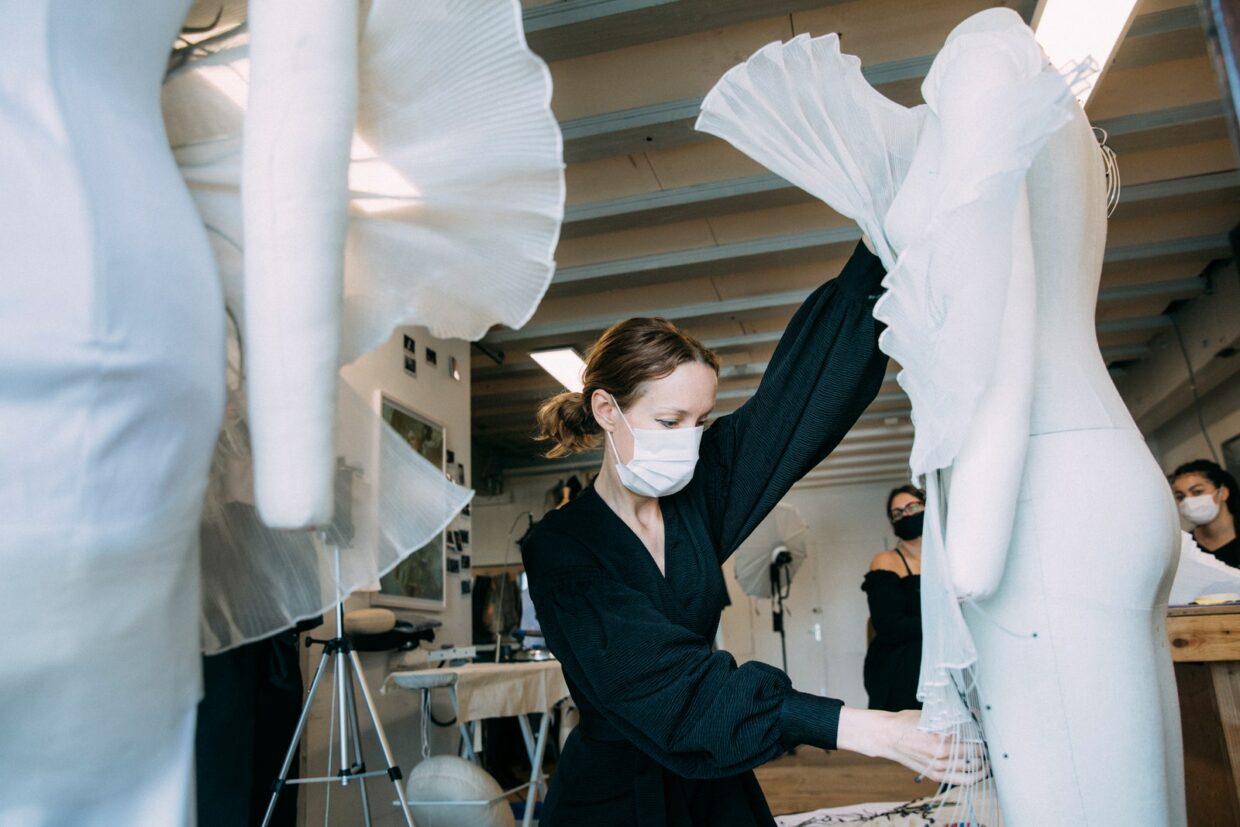Iris van Herpen Finds Beauty in “Transmotion” for the Fall 2020 Couture
Jul. 6, 2020
By Iris Van Herpen as told to Laird Borrelli-Persson
Fall 2020 marks the first season that couture, the bastion of handicraft, is going digital. Iris van Herpen, who has challenged the métier’s notion of what constitutes a unique garment by creating one-offs using technology, is well-positioned to make use of a digital platform. The designer has risen to the challenge by creating a single dress, titled Transmotion, and filming it on a hometown actress, Carice van Houten, in a short film that nods to the perspective-challenging work of the Dutch artist M.C. Escher.
The video, billed as Van Herpen’s “subconscious homage to her roots,” is a continuation of the designer’s mission to find new ways to “collaborate with nature.” “The only way forward,” she says, “is growth [in all senses of the word], and change.”
Working on this project felt like a new start. We have to surrender to the fact that things are in a state of change. I really don’t want to hold on too rigidly to the structure I’ve known before. Obviously I’m excited to work on a new collection for the January show, but honestly we just don’t know what direction the world is moving; we don’t know what’s going to happen.
I had a hard time surrendering to that in the beginning, but I’m quite okay with it at the moment. The most important lesson to me is to be flexible and to be open for change, and to use that space also to create a wider perspective. I think the fashion system will change, and this is a part of it. It’s important to not stop or to block yourself because it is [a] different [way of working]. I think we should also let go of the focus on quantity. I really don’t feel that more designs necessarily create a deeper meaning; it can actually be the opposite.
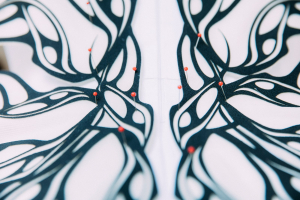
There is a strong contrast between the softness of the plissé and the graphic elements of the branching, the black and white, in the Transmotion dress. There is always a contrast between elements in my work, whether it’s [between] nature and technology or craftsmanship and innovation. I think that’s also [part] of this work, but it’s very much focused on the element of growth, representing our transition into new realms.
[The boning provides a] sort of an anatomy to the dress. There are little black beads, like seeds, in it; they are obviously the beginning of the growth, then there are transparent stems that grow into sort of black branches, and they ultimately grow into the transparent leaves that are very fragile and create a quite sculptural volume. The core and the beadwork [represent] growth, [which itself contains the idea] of strong, feminine empowerment. I felt it was very beautiful that the branching actually comes from the center of the body, where I guess all of our lives start. It was important for me to trap that feminine power, that movement [which] grows from the center, inside the design language.
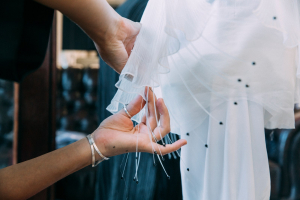
Movement and motion have always been important [sources] of inspiration, but at this moment it felt very important to look at [those concepts] in more detail and to honor them in this work. Sometimes standing still creates an even bigger movement or motion as a whole. I think that’s important and it felt like something that I needed to represent with this piece.
I relate motion and movement to growth, and that is a very important [concept, one that’s needed] to envision a better world, and to nurture that bloom of a better world. The only way forward, obviously, is growth and change, and that’s something I tried to poetically [weave into] the design language.
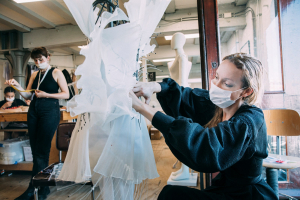
The dress doesn’t really have an upside or downside. Visually there is no difference between top and bottom or even front and back. It’s partly inspired by the work of M.C. Escher, a Dutch artist who [considered] the nature of perception and challenged the way we look at things. In his work there’s not a strong up or down, or even negative and positive; I find it really beautiful that the negative can suddenly become positive, and the other way around. That is perhaps an important message for our times: that there is always an in-between to things. We also have to be careful about polarization.
There’s an element that’s perhaps visible in the design, that also relates to Asawa’s work, [in which] the core is very geometric, but branches out into the organic. For me that symbolizes the way we deal with nature and ourselves; we are always trying to redesign nature, to redesign our roots. That dichotomy between the geometric and the organic is a struggle within ourselves and it’s something that I felt was important to capture. It’s done quite literally as you see line work that is very controlled and structural that grows into the branching and the fragility of the leaves, which are much less controlled. Restructuring and re-rooting ourselves is an important message that we learned over the last months. A driving force in why I create at all is searching for a collaboration with nature, and for a new way of collaborating with nature. I think that’s an important message for everything we do, in every discipline, and it’s becoming more and more important, every day as the pandemic has prominently, and painfully, showcased.
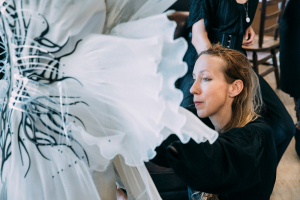
[Along with the dress, we created a video featuring Carice van Houten.] There have been some really extraordinary women from the Game of Thrones that we were lucky to collaborate with, but funnily enough, I haven’t seen [the show] myself. I’m like the last person on this planet that hasn’t. I grew up without television. But I’ve been an admirer of Carice for many years. I took her—what I know of her—as an inspiration as part of the design process. The dichotomy between strength and fragility is very prominent in her acting, and it corresponded well with what I had in mind.
What I also find special is that we live in the same city. I think the last months have been more of a celebration of the people that are physically close to us. The world is less global and it felt nice to include that conceptually with whom we worked with as well. It felt special that we share the same ground, so to say, and to [express] that in the video, which is shot in Amsterdam, the city which we both call home.
Source: Vogue


